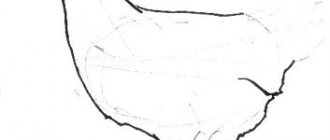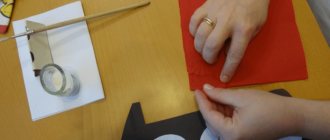April 29, 2015
We've already talked about the golden ratio, now let's look at other compositional elements that can be used in photography.
A very powerful tool for improving composition in photography is the use of lines . Firstly, they create a mood, and secondly, they “lead” the viewer’s eyes through the photograph to the main subject of the photograph. The photographer seems to take the viewer by the hand and lead him through the area, showing the way.
Lines in a composition can be divided into the following types:
- horizontal;
- vertical;
- diagonal;
- all the rest are broken, curved, arched, “S”-shaped, etc.
HORIZONTAL LINES IN COMPOSITION
Horizontal lines represent serenity and peace, balance and infinity. In a photo they give the feeling that time has stopped and can be used to contrast with another more dynamic part of the photo. The line of a reservoir, the horizon line, fallen objects, sleeping people - these are all examples of images that speak of permanence and timelessness. To prevent photographs consisting entirely of horizontal lines from being boring, you need to add some object to the frame. A beautiful stone on the seashore that touches the sky, a lonely tree in a field, etc.
VERTICAL LINES IN COMPOSITION
Vertical ones convey the mood of power, strength, stability (skyscrapers) as well as growth and life (trees). The correct use of vertical lines can also impart a sense of peace and tranquility. For example, a tree in a fog-shrouded forest, old pillars in the water, or a field, a figure on a secluded beach early in the morning. When vertical lines are repeated, they create rhythm in the photograph and enhance dynamics.
Generalized curves[ | ]
A more general definition of a curve for the case of a plane was given by Cantor in the 1870s:
Cantor curve
is a compact connected subset of the plane such that its complement is everywhere dense.
An important example of a Cantor curve is provided by the Sierpinski carpet. Whatever the Cantor curve L {\displaystyle L} , it can be embedded in the Sierpinski carpet, that is, the Sierpinski carpet contains a subset L ′ {\displaystyle L'} , homeomorphic to L {\displaystyle L} . Thus, the Sierpinski carpet is a universal flat Cantor curve.
This definition was subsequently generalized by Uryson:
Urysohn curve
is a connected compact topological space C {\displaystyle C} of topological dimension 1.
The Sierpinski carpet satisfies this definition, so every Cantor curve is also a Urysohn curve. Conversely, if a flat connected compact set is a Urysohn curve, then it will be a Cantor curve.
DIAGONAL LINES IN COMPOSITION
Diagonal lines indicate movement and add dynamism to the photo. Their strength lies in their ability to hold the viewer’s attention: his gaze, as a rule, moves along the diagonals. Examples of diagonals are numerous: roads, streams, waves, tree branches, etc. You can place multiple objects diagonally. The colors of one object can also be diagonal. Using diagonal lines, place them just above or below the left corner of the photo as our eyes scan the image from left to right. This will also prevent the frame from being visually split into two parts. Always leave “room for a step” in front of a moving object - this will give it even more dynamics.
CURVE LINES IN COMPOSITION
Curved lines are elegant, sensual, dynamic, creating the illusion of liveliness and diversity. They can bring an object closer or further away or create balance. “C”-shaped curved lines or arcs are the most common - because they are the shore of the sea, lake, rounded stone, rock or curved stems of grass. If we talk about architecture, then these are arches. Several repeating arches look very impressive.
Mutual arrangement of points and lines
A point may belong to a line (that is, be one of its components), or may not belong to it.
For example, in Figure 4.1, points M and O belong to line c , but points D , Z , F do not belong to line c .
Rice. 4.1 Belonging of line points
When writing in writing, a dot is indicated using a dot sign enclosed in brackets, with the addition of a capital letter of the Latin alphabet: (·) H
In order to show whether a given point belongs to a line or not, a symbol of belonging is used, resembling a mirrored inverted capital Russian letter E: ∈ . If the point does not belong to the line, then use this symbol in a crossed out form: ∉ .
Now I will write down what we saw in Figure 4.1 in the language of geometry, and you try to read it yourself:
- (·) M ∈c
- (·)O ∈c
- (·)D ∉c
- (·)Z ∉c
- (·)F ∉c
S-SHAPED CURVE IN COMPOSITION
Such lines are also called beauty lines. This is an aesthetic concept, a component of artistic composition, a wavy, bending curved line that gives the image a special grace. The human body is the best example, from the arch of the foot to the curve of the neck.
The “S” shaped curve is the mouths of rivers, winding roads, paths.
The frame can combine straight and curved lines. This gives the frame composition balance and stability. The body of this acoustic guitar is a perfect example of the "S" shaped curve. Notice the use of other lines in this photo - the diagonal lines of the guitar strings, and the horizontal lines - the sheet music in the background.
Drawing a curved line
See also: “How to make a gradient in Photoshop”
Like polylines, curves are divided into two types: open and closed. There are many tools and methods for constructing a curve in Photoshop.
Open curve
To create such a line there is only one tool - “Pen” (followed by a stroke). Or you can draw such a line manually.
Closed curve
There are three ways to create a closed curved shape in Photoshop.
Lasso
Using the lasso, you can create curves of absolutely any configuration. You need to make a selection using this tool. And then trace the outline with any available tool.
Oval area
When using this tool we will get an oval area. We make a stroke again. This oval can then be modified using the Free Transform we talked about earlier. Press CTRL+T to invoke this function. On the grid that appears, you can easily change the shape and achieve the desired shape.
Figure
Let's take the Ellipse tool. In the top menu, set the required settings and create an oval shape.
After which the resulting circle can be changed to obtain the desired shape. To do this, select “Deformation” and create.
Result after applying deformation:
That's all. We showed you how to create lines in Photoshop in different ways. These skills will come in handy when constructing various grids, outlines, and layouts.
See also: “How to enlarge an image in Photoshop”
BROKEN LINES IN COMPOSITION
Broken lines give the pictures an alarming and even aggressive character. This impression when viewing photographs with broken lines occurs due to the fact that the eye often has to “jump” along the lines and change direction.
Creating a polyline
This type of line is essentially a combination of several straight lines. A polyline can be open or closed, forming a complex or simple polygon. In this regard, the methods of its construction may differ. Let's consider two methods of its construction.
Open broken line
The easiest way to create such a line is to use Photoshop's Pen tool.
A separate and quite detailed article on the Pen tool in Photoshop in one of our lessons: How to use the pen in Photoshop
This is a truly universal tool that allows you to draw anything. Whether it's a simple corner or a square, or a shape with a lot of edges. You can learn more about this tool by going to the corresponding article, where we have already talked about this tool.
To draw the line we need using a pen, you only need to complete two simple steps.
- Mark the required number of anchor points in the required locations.
- Then you need to outline the resulting outline. For this purpose, you can use any of the available program tools. We chose “Brush”.
You can go another way. Draw the required figure by drawing several straight lines. First, draw the first straight line, which will be the basis.
Next, create the required shape using the layer copy function (called by the keyboard shortcut CTRL+J)
and the “Free Transform” option (to do this, use the keyboard shortcut CTRL + T).
Creating a closed polyline in Photoshop
As we said above, broken lines come in two types. A closed polyline is a polygon with any number of faces. There are two methods for constructing such a figure in Photoshop. The easiest way is to use a special program tool - “Figure”. Or you can create a selection of the desired shape and then stroke the path.
Method number 1 - figure
Using this tool will produce the selected geometric shape. The sides and edges will be absolutely equal.
If we only need to get the outline of a given shape, we will need to make a stroke, called “Stroke,” accordingly. This tool has its own settings: size, color, length and stroke spacing. Let's say we take a solid stroke. But we initially made a shape with a stroke and showed in the screenshot where to select this option. See picture above.
But if we need to leave only the stroke, then we need to turn off the fill parameter, after which we will just get a figure without a background.
The resulting shape can be modified using the Free Transform tool. Deform and rotate the shape as many times as you like to achieve the final result.
Method No. 2 - straight lasso
Using this tool it is possible to build figures of absolutely any complexity and configuration. To do this, you need to create several anchor points and select the resulting area.
Then you need to outline the resulting figure. This is done using a special function that can be called by right-clicking on the shape.
In the window that opens, you can set the necessary parameters, such as size, color and position of the outline.
Click “OK” and get the result:






